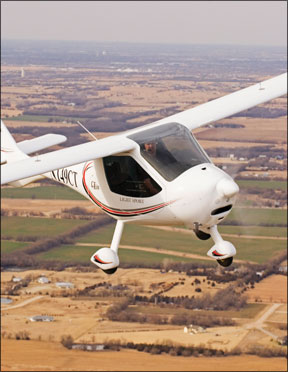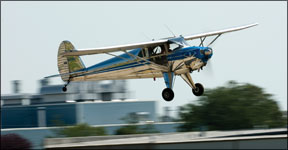By all the usual parameters, people are turning to the new light sport aircraft (LSA) category and its accompanying sport pilot certificate in large numbers. Both apparently are having a favorable, if perhaps modest, impact on private flying in the U.S. The new aircraft category has translated into options and a new airman certification scheme so far posting some formidable numbers: About 60 new S-LSA Dave Higdon 288 types-special light sport aircraft, a factory-built, ready-to-fly machine-have been approved by the FAA under industry-developed consensus standards as of November 2007. Nearly 1100 new S-LSAs were registered through the same period. And, according to the Experimental Aircraft Association (EAA), as of July 2007 when association Vice President Earl Lawrence delivered a three-year report on the movement, 2100 new sport pilot certificates had been issued, along with 232 sport pilot instructor certificates and 240 examiners. Not too shabby, considering the FAA didnt publish the final sport pilot rule until August 2004; it was April 2005 before the first S-LSA won approval from the FAA. The recreational-or-better pilot looking for more economical flying opportunities, more fun or simply a less-restrictive environment may find the LSA and sport-pilot privileges are the way to go. But there are some nuances to the new rules. And, as with any different technology, ensuring a safe transition may require extra effort. The last thing a transitioning pilot should do is think he or she can simply kick the tires, climb in and take off safely. The Basics The LSA aircraft and sport pilot certificate numbers dont reflect any already-certificated pilots opting to exercise their privileges in an LSA. Similarly, none of those LSA registrations includes the use of older, existing aircraft certificated under CAR 3/FAR 23 and eligible for operation as an S-LSA. Dubbed “legacy LSAs,” these are generally older tube-and-fabric taildraggers. See the sidebar on page 20 for more details. Confused yet? Dont be; its all relatively simple. And attractive: The LSA category has spawned a wide variety of innovative and economical airplanes usually costing Dave Higdon 288 far less than a new FAR 23-compliant flying machine. The appeal of a modern airplane for the price of something three, four or five decades old is one thing. The ability to keep flying without a medical certificate-whether by choice or circumstance-is another attraction for pilots. For a pilot already holding a recreational pilot certificate or better, exercising sport pilot privileges requires only a valid state-issued drivers license to comply with the medical certification requirements. A pilot may not have had an FAA medical denied, revoked or suspended to be eligible to exercise sport pilot privileges. A pilot whose medical has expired? No problem. Meanwhile, as with anything, the small print deserves some attention. A couple of the less-understood aspects of the LSA involve the regulatory requirements with which an already-certificated pilot needs to comply before flying them. Transitioning Lets presume youre a private pilot (or better) with a chunk of time in your 288 logbook, maybe even an instrument rating and time flying the challenging world inside the egg shell. How hard can this be? Fixed gear is fixed gear; fixed prop is fixed prop; and two seats-well, you get the idea. Yes, having the typical single-engine land rating on your certificate does legally qualify you to fly an LSA. You wont need to go through the 20 hours of flight instruction required for the sport pilot certificate or pass the LSA knowledge (written) test. The only other thing youll need to do is ensure your existing endorsements and ratings are appropriate to the LSA you want to fly. For example, if you want to fly a single-engine conventional-gear airplane (a taildragger), but you only have flown tricycle-gear airplanes, youll need an appropriate logbook endorsement. Same for a seaplane. This is different from the rules applying to sport pilots, who must obtain training and an instructors logbook endorsement before flying different makes and models of light sport aircraft. For the long-inactive private pilot, one who hasnt flown in years and with a lapsed medical, the path back via the LSA is easy. Get some dual from a CFI or sport pilot instructor, a flight review and youre good to go. Importantly, no sport or other pilot is exempt from the two-year (biennial) flight review requirement. As long as you have a drivers license, you have a medical. Privileges As a private pilot (or higher) with a valid medical certificate, you can exercise options unavailable to the sport pilot. For example, an LSA equipped to meet night-lighting standards and the operations handbook for which includes night flight, can be flown between sunset and sunrise by a night-legal private pilot, even though a 288 sport pilot cannot fly at night in the same airplane. The additional training required for a sport pilot to fly at night is the private pilot license. Ditto for flying into airspace requiring ATC contact, as long as the LSA is equipped with the proper radio and transponder as factory equipment, and its use is covered in the aircrafts handbook. Another privilege available to the private pilot or higher holding a current medical certificate is instrument flight but, again, only if the LSA is properly equipped and IFR is approved in its handbook. According to Dan Johnson of the Light Aircraft Manufacturers Association, the aviation community is working with the ASTM and FAA in expanding the consensus standards. The hoped-for results would incorporate and approve some of the non-TSOd, non-approved panel gear for instrument flight of LSAs, similar to the way gear must be factory-specified for VFR LSA flight. Currently, an LSA factory can equip its aircraft with TSOd gear needed for IFR flight and include IFR operations in its operating standards for the aircraft. Safety Dave Higdon 288 But how safe are these machines? Does the lack of FAR 23-style FAA certification have an impact? What about crashworthiness, maintenance requirements or engine reliability? When considering overall safety, for example, most systems are straightforward and most powerplants have been around long enough to develop a record. But first, lets tackle LSA certification. The ASTM standard for LSAs is similar to FAR 23, but different. For example and according to the EAA Web site 




Although we consider it too soon for the category to have established a safety record, crashworthiness should be comparable to aircraft of similar weight and capability. One factor worth mentioning is the widespread use of airframe

Dave Higdon
288
parachutes among LSA manufacturers.
Maintenance, too, is similar, but different. An S-LSA aircraft will be required to have 100-hour inspections when being used in a flight school or for rental. Additionally, a “condition inspection” must be performed each 12 calendar months, regardless of the types of operations in which the aircraft is engaged. The aircraft will need to be maintained by a person with a LSA repairman certificate with a maintenance rating, by an A&P mechanic or by an appropriately rated FAA repair station.
The LSA rule and the industry it spawned have broadened the horizons of anyone wanting to become a pilot or continuing to fly. In addition to understanding a new regulatory framework, prospective owners and pilots will need to understand the differences-and similarities-between LSAs, sport pilots and the conventional requirements and responsibilities of FAR Parts 61 and 91.
In subsequent articles, well look at these and other topics, including the overall safety record being earned by LSAs, powerplant and system characteristics, “legacy” aircraft and the implications of these options.
Dave Higdon is a professional aviation writer/photographer with several thousand hours of flight time in many aircraft types, including hang gliders, ultralights and LSAs.



